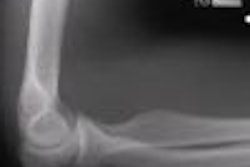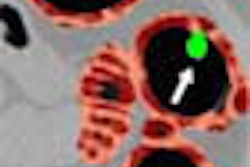Anyone attending a scientific session at the 2002 RSNA meeting in Chicago could look around the room and safely assume that nearly everyone there is an imaging expert of some sort, be it clinical, research, technical or administrative.
Attendance figures from the 2001 conference would bear this out: According to the official registration numbers, out of the 53,033 people in attendance, only 162 were designated as "other physicians."
But the reality is that outside the walls of McCormick Center, more non-imaging specialists are performing diagnostic imaging exams. And while turf invasion in important issue, radiologists also need to look beyond how much ground they are potentially losing -- to the likelihood that non-radiologists may overuse imaging, driving up the cost of health care and bringing increased scrutiny to the imaging industry.
"In private settings, about two thirds to three quarters of the imaging is done by non-radiologists," said Dr. David C. Levin, former chairman of radiology at Thomas Jefferson University Hospital in Philadelphia.
Levin is in a position to know: He has devoted himself to tracking the imaging practices among non-radiologists and the frequency with which they are performed. According to Levin’s research, much of the growth in radiology in the last decade is due to its use by non-radiologists.
How bad is it? In a study that reviewed data from the entire U.S. Medicare population from 1993-1999, Levin and colleagues found that imaging utilization (per thousand) among radiologists was virtually unchanged over six years ("Growth in Utilization of Noninvasive Diagnostic Imaging Among Radiologists and Nonradiologists: A Nationwide Comparison between 1993 and 1999," RSNA 2001).
On the other hand, the Medicare data also showed that "if you then look at the non-radiologists, their utilization rates went up by 25% over those six years. Their relative value unit (RVU) rates went up by 33% over those six years." Professional-component RVUs are a proxy for cost. Medicare calculates reimbursement by multiplying professional-component RVUs by a dollar conversion factor.
According to Levin’s study, the RVU rate per thousand for radiologists in 1993 was 1,395. In 1999, radiologists’ RVUs had increased 7 percent, to 1,492 per thousand. In contrast, nonradiologists’ RVUs had increased 32.5 percent in those three years, from 578 in 1993 to 766 in 1999.
What is driving non-radiologists to perform their own imaging exams? In Levin’s opinion, financial gain is one reason. He cited a 1965 study in which Childs and Hunter studied plain radiography use among a group of clinicians who self-referred using their own in-office equipment and another group who referred patients to radiologists. The self-referring clinicians used imaging twice as much as the radiologists. (Medical Care, July-August 1972, Vol.10:4, pp. 323-335).
"MDs who care directly for patients can start buying their own imaging equipment and doing studies on their own patients. By self-referring in this manner, they can begin collecting fees for those imaging studies, even though the patient may not necessarily need the imaging test. On the other hand, radiologists don’t have the opportunity to self-refer, even if they wanted to," Levin said.
The availability of technology creates another temptation. In 2002, Oguz and colleagues compared the use of brain and spine CT by emergency-department physicians in the year before and the year after a CT scanner was installed in the emergency department (ED) of Johns Hopkins Hospital.
The radiology department controlled the scanner, and so the ED physicians had no financial incentive to order more CT. Nevertheless, the percentage of ED patients sent for brain or spine CT rose from 7.9% in the year before installation to 13% the year after installation. (Academic Radiology, September 2002, Vol.9, pp. 1018-24).
It’s no surprise that, according to the data, the bulk of the imaging load has been taken on by cardiologists. Another of Levin’s studies, which looked at the growth in cardiac nuclear scanning between 1996 and 1998, showed that "in those two years, the utilization rate among cardiologists increased ten times as much just in those two years as it did among radiologists," Levin said (Radiology Online, October 17, 2002).
One issue still up for debate is whether it is appropriate for non-radiologists to perform imaging exams. Levin said that he has not examined the appropriateness of non-radiologist-performed diagnostic imaging exams, but he argued that "you sort of have to extrapolate from the data."
Published reports do show that non-radiologists perform poorly and make significant errors when interpreting diagnostic imaging. In one study, Alfaro and colleagues assessed emergency medicine physicians’ accuracy in interpreting head CT scans and found that they made clinically significant misinterpretations in 24% of cases (Annals of Emergency Medicine, February 1995, Vol. 25:2, pp.169-174).
Another study found that emergency department staff the interpretation of plain radiographs found that the ED staff missed 35% of all positive findings and 39% of all clinically significantly positive findings (Archives of Emergency Medicine, June 1988, vol. 5:2, pp. 101-109.)
A study by Reinus and colleagues evaluated the ability of ED physicians to interpret plain radiographs, allowing them to send the difficult cases to radiologists. Among the studies the physicians felt confident enough to read, they made significant errors in 9% of cases (Emergency Radiology, July-August 1995, Vol.2: No. 4, pp. 207-213).
But there are those who believe that other doctors are well within their rights to do their own imaging, Jill Rathbun, a managing partner at Galileo Consulting Group in Arlington, VA, noted that some specialists, such as surgeons, handle image-guided procedures without a radiology assist because they have the skill-set to see the surgery through.
"Radiologists can place biopsy needles and do ultrasound, and it’s not clear what training they have to do a surgical biopsy procedure. But surgeons can’t do an ultrasound with a biopsy procedure (and get reimbursed for it)," she said.
Galileo is currently working with the American College of Surgeons in support of the American Medical Association’s call for reimbursement for any doctor who uses ultrasound.
Another point of contention is education. How to define the appropriate level of training in a particular modality?
According to Levin, the highest level of skill for interpreting scans is reached only "through long years of training and experience. Non-radiologists (during residency, fellowship, and on into years of subspecialty clinical practice) receive little or no training in image interpretation."
Levin pointed to studies that show that ED physicians’ performance in reading imaging scans fails to improve with increasing experience. In a study comparing interpretations of ED radiographs by internal medicine residents with final interpretations by staff radiologists, medical residents failed to detect clinically significant abnormalities in 11% of cases (Journal of General Internal Medicine, September-October 1986, Vol.1, pp. 295-299).
Only a handful of studies have compared the quality of diagnostic imaging studies performed by radiologists vs. non-radiologists. A study by Edmiston and Levin reported on the results of a quality audit conducted by Pennsylvania Blue Shield, involving approximately 1,100 radiographic examinations produced in the offices of radiologists, orthopedic surgeons, general and family practitioners, internists, pulmonologists, podiatrists, and chiropractors.
The researchers found the lowest incidence of unacceptable film quality among radiologists (12%), followed closely by orthopedic surgeons (13%). Among the other physician groups, the incidence of unacceptable film quality ranged from 41% to 82%. (Radiology, December 1992, Vol.185:3, pp. 701-704).
In a smaller study, Hopper and colleagues found technically inadequate quality in 28% of chest radiographs produced by non-radiologists, compared with only 3% among radiologists. (Radiology, August 1991, Vol.180:2, pp. 557-561).
In the end, the cut-off point for determining who is qualified to render and interpret exams may be determined by the one issue that all doctors face: the current malpractice crisis.
"My experience has shown that, in general, medical malpractice underwriters would see (non-radiologists performing and reading diagnostic imaging examinations) as a negative, and would most likely require that they provide proof of additional training and so forth before they would insure them for that," commented T. Lloyd Croft, the Midwest regional vice president for Houston-based Professional Medical Insurance Services.
The fact that in some states, specialists such as ob/gyns are having trouble even obtaining malpractice insurance may drive non-imagers out of radiology altogether. By the same token, radiologists are going to have to step up to the plate, Levin said, working to convince payers that they are qualified to use imaging efficiently and effectively.
Until then, this issue of utilization use by non-radiologists will continue to concern the imaging community. A Health Services, Policy and Research session at the 2002 RSNA will be devoted to utilization and practice management (track K13, December 4, 2002). Presentations include two studies from Thomas Jefferson University, regarding which specialists perform the bulk of vascular interventional radiology procedures (papers 1127-1128).
Dr. Lawrence Parker and colleagues from the same institution will discuss utilization and cost trends in musculoskeletal imaging in the Medicare population (paper 1047), as well as usage and costs of neuroimaging (paper 1049).
By Leslie FarnsworthAuntMinnie.com contributing writer
November 25, 2002
Related Reading
Many radiology exams in Germany improperly performed, November 8, 2002
Radiology rankled by AMA call for universal ultrasound reimbursement, August 8, 2002
Multidisciplinary boards might calm radiology's raucous turf battles, August 1, 2002
Research and education will win the radiology turf wars, according to Dunnick, July 8, 2002
Medicare database shows radiologists losing turf, December 27, 2001
Copyright © 2002 AuntMinnie.com



















